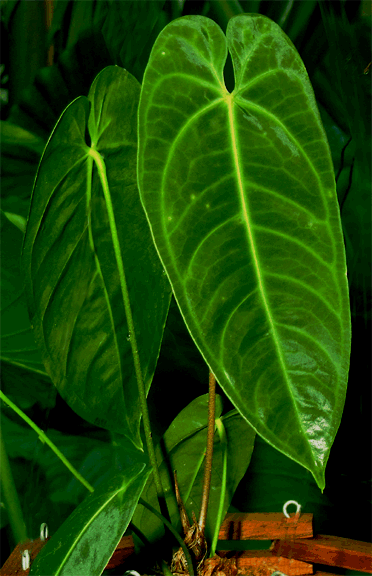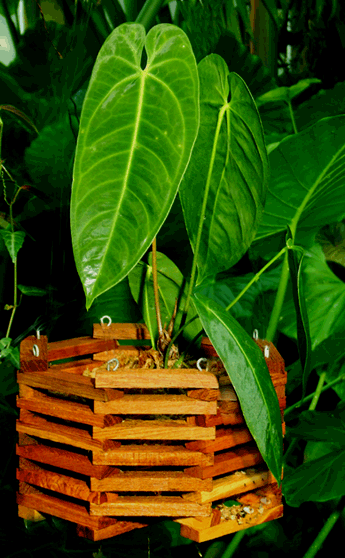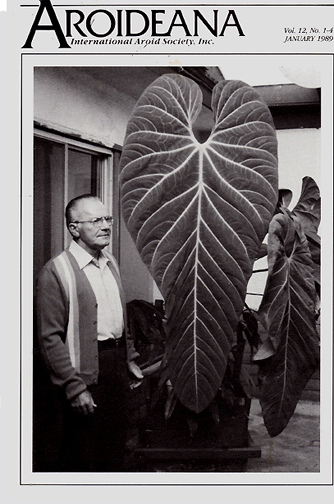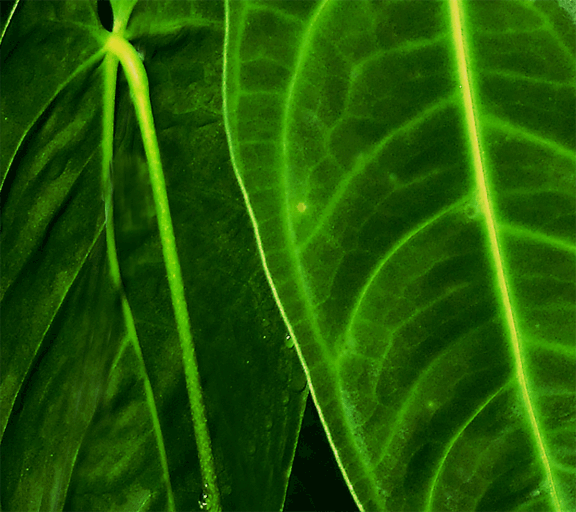![]()
Aroids and other genera in the Collection
Take the Tour Now?
Orchids
The
Exotic Rainforest
Plants in
the Exotic Rainforest Collection
The images on this website are copyright protected. Please contact us before any reuse.
Detailed information on Growing Anthurium Species
Click this Link
Within our collection we have many species of Anthurium. If you are seeking other photos, click this link:
Possibly an undescribed species

Possibly an undescribed species
For more information on Anthurium angamarcanum Sodiro click this link
Luis Sodiro was a Jesuit priest serving in Ecuador who described many tropical aroid species. Sodiro described Anthurium marmoratum in 1903 and worked in Ecuador from 1870 to 1909 describing a total of 281 taxa of Ecuadorian Araceae, largely Anthurium species. He was the first botanist specializing in aroids to be considered a field botanist and spent most of his career in the Ecuadorian tropics. Born in Italy in 1836, Sodiro served in Ecuador until the time of his death.
 Unknown to early botanists,
and unfortunately for Sodiro, numerous Anthurium
sp.
frequently have variations in their blade appearance. Numerous
botanical records have pointed out confusing information in Sodiro's
notes. Sodiro actually
gave different names to several Anthurium specimens which
have since proven to be a single species, some numerous times. And this may be the case
with the specimen Dr. Croat and Dr. Ron Kaufmann are calling Anthurium marmoratum.
Unknown to early botanists,
and unfortunately for Sodiro, numerous Anthurium
sp.
frequently have variations in their blade appearance. Numerous
botanical records have pointed out confusing information in Sodiro's
notes. Sodiro actually
gave different names to several Anthurium specimens which
have since proven to be a single species, some numerous times. And this may be the case
with the specimen Dr. Croat and Dr. Ron Kaufmann are calling Anthurium marmoratum.
At present, aroid botanist Dr. Tom Croat of the Missouri Botanical Garden is studying the possibility this and other specimens may be Anthurium angamarcanum. That species is known to be variable and have more than one growth form and as a result may actually incorporate several named species (now synonyms). But at this moment, until more work can be done on this group, it has been elected to continue referring to our specimen as Anthurium marmoratum despite the fact it may possibly be something else. The plant has a velutinous (velvet) appearance to the leaf blade. Anthurium species are known to be highly variable and not every leaf of every specimen will always appear the same. This link explains in greater detail the scientific principle of natural variation and morphogenesis. Click here.
In Sodiro's published descriptions and other sources Anthurium angamarcanum and Anthurium marmoratum are known to both slopes of the Andes Mountains in Ecuador and possibly Colombia. The dates noted above are significant. Should this species finally prove to be a variation of Anthurium angamarcanum that name will take precedence due to having been described earlier than Anthurium marmoratum.
The type specimen of Anthurium marmoratum was discovered by Sodiro in Ecuador along the rivers known as the Río Toachi and Río Pilatón. Described in his published work as an epiphytic climbing Anthurium sp., Anthurium marmoratum is truly a hemiepiphyte (hem-a-EPA-fit) but also grows as a terrestrial Anthurium. An epiphyte (ep-a-FIT) is a plant that grows upon another plant, a tree, but may also be capable of beginning life in the ground and then climb a host tree finally sending roots down to the soil. Plants that begin life as a seed placed on a tree's branch by a bird, and never need to grow in soil, are pure epiphytes. Hemiepiphytes can grow in the soil as well as climb a host. However, please keep in mind it is unclear if this specimen is truly Anthurium marmoratum. As a result, we are uncertain if this specimen is an epiphyte or a hemiepiphyte.
According to Sodiro, the stems of the type of Anthurium marmoratum are known in botany as "appressed". That simply means the climbing plant grows very close to the tree. The leaf blades are supported on long petioles which can measure between 80 and 100cm in length (2.75 to 3.3 feet). The blades were described by Sodiro as being "stiff and brittle" and "speckled with reddish or grayish green". The blades are semi-glossy and measure 45 to 120cm long (1.5 to 4 feet). and 15 to 40cm (6 inches to 1.3 feet) wide. The leaf blades are velvety in appearance and are typically 2.4 to 3 times longer than wide and are considered cordate (heart shaped) at the top of the lobes. As a result of the velvet blade adaxial (upper) surface, Anthurium marmoratum is a member of section Cardiolonchium along with popular collectable species such as Anthurium crystallinum, Anthurium magnificum, Anthurium warocqueanum and Anthurium regale.
 Our
specimen came from Dr. Ron Kaufmann in San Diego. In regard to the
specimen we are currently calling Anthurium marmoratum, marine
scientist, avid
aroid researcher, and collector Dr. Kaufmann informed me the parent
specimen is from Colombia. At this point I do not have a precise
location. He also said in an email in June, 2007, "there's considerable confusion with names; the type specimen of A.
marmoratum Sodiro may be just another A. angamarcanum, according to
Tom. In that case, what we call A. marmoratum may be an undescribed
species, but most of my friends and I have been using "A. marmoratum" to
mean the plant pictured on my web site, which is clearly distinct from
A. angamarcanum."
http://home.sandiego.edu/~kaufmann/aroids/anthurium_marmoratum.htm
Photos of a larger specimen of this
Anthurium
can be found on Dr. Kaufmann's website.
Our
specimen came from Dr. Ron Kaufmann in San Diego. In regard to the
specimen we are currently calling Anthurium marmoratum, marine
scientist, avid
aroid researcher, and collector Dr. Kaufmann informed me the parent
specimen is from Colombia. At this point I do not have a precise
location. He also said in an email in June, 2007, "there's considerable confusion with names; the type specimen of A.
marmoratum Sodiro may be just another A. angamarcanum, according to
Tom. In that case, what we call A. marmoratum may be an undescribed
species, but most of my friends and I have been using "A. marmoratum" to
mean the plant pictured on my web site, which is clearly distinct from
A. angamarcanum."
http://home.sandiego.edu/~kaufmann/aroids/anthurium_marmoratum.htm
Photos of a larger specimen of this
Anthurium
can be found on Dr. Kaufmann's website.
Ron went on to say, "compare the
leaves, growth habits, and especially the inflorescences. They're hard
to separate when they're juveniles, but the differences become very
clear as they mature." As a result, since our specimen came
from Dr. Kaufmann's collection, and is currently being investigated by
Dr. Croat, we are uncertain if the specimen shown above is truly
Anthurium marmoratum, Anthurium angamarcanum or possibly a species
undescribed to science.
Photos of the inflorescence of Dr. Kaufmann's unusual
specimen can be seen on his website. In early August, 2007 Dr.
Kaufmann's specimen measured approximately 120cm (4 feet) long by 60cm
(2 feet) wide at the widest point.
Although Ron's specimen is currently smaller, the interesting thing about Dr. Kaufmann's Anthurium (photo left), of which ours' is the same, (please see his website for a closer comparison) is its close match in shape to an odd Anthurium sp. specimen pictured on the cover of the International Aroid Society's journal Aroideana in January, 1989, Volume 12, 1-4. That photo was taken by renowned aroid collector Dorothy Henkle (now deceased) and published with the following caption, "Anthurium species (section Cardiolonchium) collected by Dorothy Henkle 1981 in central Colombia at 6,000 feet. Leaf is six feet one inch long and almost dwarfs Jack Henkle. Grown by Dorothy Henkle. Photo by Dorothy Henkle." No one is certain what happened to the Hinkle specimen following her death. Dorothy was one of the earliest members of the International Aroid Society (IAS). You can further compare Dr. Kaufmann's specimen to the Henkle specimen (photo right) on his website.
So is it the same plant? I asked Dr. Croat and received this response, "As I recall Dorothy Henkle found this plant in Colombia at Tequendama, a very different area from where A. marmoratum comes from. It is also much larger than any A. marmoratum that I have seen. It is very similar though."
Dr. Kaufmann
made this observation regarding the similarity of the two Anthurium
specimens, "I have at least one friend
who is skeptical that the Aroideana cover plant is the same as A.
marmoratum. I'm not sure, but they do look very similar...
Wish
someone had more photos of that plant than just the one on the Aroideana
cover. I have two other photos of the same
 plant with a juvenile leaf,
but none of the inflorescence or cataphylls."
It appears,
since no one knows for certain what species the Henkle plant actually
was, we may never know if her specimen was or was not
Anthurium marmoratum or a totally undescribed species.
plant with a juvenile leaf,
but none of the inflorescence or cataphylls."
It appears,
since no one knows for certain what species the Henkle plant actually
was, we may never know if her specimen was or was not
Anthurium marmoratum or a totally undescribed species.
Although we are unable to verify the location, a note from Anthurium hybridizer and expert Jay Vannini in Guatemala noted a division of the near legendary Henkle plant is said to be in a collection in Queensland, Australia. That plant is reported to not be thriving at this time. Jay also stated, "One thing that I have noted about all the plants from this group is that they do get huge over time...I have about 20 plants from a grex that has an undescribed elongate-leaf Cardiolonchium as seed parent and "true" Colombian marmoratum as a pollen parent that generate 60cm long leaves three years from seed with less than 10cm of stem. I assume that they will attain immense dimensions three or four years hence." Another report claims the Henkle specimen was donated to a botanical garden and subsequently died. That information cannot be confirmed.
My friend and aroid expert Julius Boos also noted, "All growers and taxonomists are in agreement that within the section Cardiolonchium, hybridization is easily achieved by hand pollination. So it will be most interesting to collect in areas where the different species within this widely distributed section may be known to occur in sympatry. It would be logical to expect hybrids and intermediates of the different species to exist where they do in fact overlap. This ''mixing of the genes" in these areas might just turn out to be the explanation of the mystery surrounding our plants true identity".
Dr. Croat provided a great deal of additional information in this July, 2007 email. "There may well be two species masquerading as A. angamarcanum. I consider them to be the same species because the type specimens seem to be identical. I have studied material called A. marmoratum in Ecuador at the type locality at the junction of the Río Pilaton and the Río Toachi and there it was terrestrial, creeping over steep banks. The internodes were often longer than broad and it had loose, fibrous cataphyll fibers. At Reserva Guaycuyacu on the other side of Volcán Pichincha near Imbabura the same plant (seemingly) was present on the ground but there were also appressed-climbing hemiepiphytic plants on the trees nearby and Jim West insisted that they were the same. He should probably know since he has seen many of these. The terrestrial plants had no inflorescences on my trips there but the hemiepiphytes had thick stems with relatively short internodes and erect-spreading peduncles, erect violet-purple spadices and a pale green, reflexed spathe. I have seen something very similar if not the same at Lita and also in the Chical area. Unfortunately I have not had time to get the stuff out and compare it all at the same time."
Making this quest even more interesting, on the evening of August 2, 2007, I received this
note from Dr. Croat,
"Ron
and I discussed the differences in two plants that he has, both of
which are competing to be A. angamarcanum (which in my opinion is
the older name for marmoratum). Ron is going to try to get vouchers
to me so that I can make detailed descriptions of both
 plants.
Actually, I am going to be in Ecuador for a couple of months and may
try to find more material, or at least study some of the material in
the field, and make careful note to see the characters that Ron
showed me on his plant. I assume one of them is likely to be new so
I will need adequate material for a type specimen and a fixed type
locality. One of Ron's plants came from Maldonado and while I have
not seen this thing at Maldonado it is very common slightly lower
down at 1200 m in El Chical. Since my next proposed floristic study
site will be in that region I will be returning there several
times."
plants.
Actually, I am going to be in Ecuador for a couple of months and may
try to find more material, or at least study some of the material in
the field, and make careful note to see the characters that Ron
showed me on his plant. I assume one of them is likely to be new so
I will need adequate material for a type specimen and a fixed type
locality. One of Ron's plants came from Maldonado and while I have
not seen this thing at Maldonado it is very common slightly lower
down at 1200 m in El Chical. Since my next proposed floristic study
site will be in that region I will be returning there several
times."
Jay Vannini also raised our hopes that this unusual Anthurium may finally be located and identified when he wrote in a separate note, "This opens up many possibilities with regards to populations that grow in near sympatry with marmos, as they apparently do in parts of Colombia. Certainly, I think many would agree that the angamarcanum-marmoratum thingamajigs attain greater overall blade lengths and widths than warocqueanums, and they continue to grow incrementally as long as they survive."
So is our specimen possibly the same as the legendary Henkle Anthurium? That is still unknown. But Dr. Croat sent a most intriguing note on August 6, 2007. In it he wrote, "I think I have gotten to the bottom of Dorothy Henkle’s plant. It is not as I have said, namely that she got it in Colombia at Tequendama. (Name deleted) collected it on the road between La Florida and the Paramo de Chinche in Tolima Department. (That collector) gave the plant to Dorothy Henkle. Anyway, I have collected too in this area (though I did not see this plant). I am sending a photo of (the) plant and it does indeed look like the thing that Henkle had. I hope to return to this area some time to confirm all this and to get some herbarium material because I think that this species remains undescribed." According to the new information provided to Dr. Croat by the original collector, the Anthurium was actually collected in the Colombian Andes at an elevation of 8600 feet. An additional source has revealed the original collector gave the plant to a second individual who then passed it along to Dorothy Henkle. As a result of the collection elevation, this plant would be well suited for a cool greenhouse with a wet wall. But, for now, Dr. Croat has a much more clearly defined area in which to search. Amazingly, the photo Dr. Croat sent of a much younger Henkle Anthurium looked almost identical to the photo of my plant at the top of this page!
We have elected to display and grow our specimen of what may, or may not, be Anthurium marmoratum in an octagonal orchid basket packed with sphagnum moss and a minimal amount of soil. In early August, 2007, the specimen's largest blades measured 23cm (9 inches). The plant is hanging with a large group of similar Cardiolonchium species in moderately dim light since members of this Anthurium section do not enjoy bright light. This group of specimens is watered almost daily during the summer months. We will post new photos and information as Dr. Croat completes his studies and as our specimen matures.
As it occurs in nature and by any horticulturist
Need more information on Anthurium species? Click this link.
To join the International Aroid Society click here: http://www.exoticrainforest.com/Join%20IAS.html